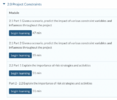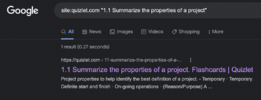- Apr 25, 2015
- 1,846
- 2
- 2,203
- 327
While easily implied, the layout for these questions and answers for practice is as follows:
This is a long question?
The Answer
If you find more studying materials, or additional content relevant to the Project+ please register by clicking here and navigating back to this thread to post a reply!
You are working on moving the in-house Human Resources Management System (HRMS) to a cloud self-service provider. One of your key team members leaves the organization and you hire a new consultant.
This is an example of what type of change?
Resource change
A stakeholder approaches the project manager with an idea for a new project.
What document will be prepared as a result of this meeting?
Business case
You are six weeks into a four-month project and the sponsor tells you that you must deliver the project a month earlier than originally planned without decreasing the scope.
Your only remaining option is:
Increase cost
You are working on a new purchasing system project and are getting ready to start executing the project.
Which of the following is a disadvantage of holding the kick-off meeting via video conferencing?
Stakeholders need to have the communication technology installed in their locations.
You are developing a new website for your organization and you are starting to identify and prioritize risks. You are meeting with the team and they are throwing out potential risks as fast as possible while you document them.
What specifically are you doing?
Using the brainstorming technique to come up with all the risks
You are developing the project plan for a new Human Resources Management System (HRMS) for your organization.
Which of the following is a type of change that you might need to plan for?
Relocation
The Project Management Office (PMO) has published a set of Key Performance Indicators (KPIs) that each project within the organization must use when preparing its monthly status reports.
Is this necessary, and if so, why?
It is necessary so PMO analysts can compare the performance of the projects using a consistent set of tools.
When are the requirements for a project using Agile methodology determined?
Continuously
You are working on the installation of a new Customer Relationship Management (CRM) system and are developing the project change control plan.
Which of the following is not a component?
A validated change
You are working on a six-month project to redesign the corporate website and add product purchasing functionality. You realize that you underestimated how long design would take and you calculated a new duration.
This is an example of what type of change?
Timeline change
You are working on the project plan for a new website design project and you are finalizing the communication plan.
Which of the following is not considered a communication trigger?
Impromptu meeting
In reviewing the project deliverables to date, the clients discover that there is a missing piece of work.
To formally ask for this work to be added to the project, they need to submit a:
Change request
Early in the planning phase of a project, the project manager identifies a critical work package that needs the expertise of the company’s most senior database developer. The project manager and the functional manager agree that this person can be assigned exclusively to the project.
Which type of resource is this?
Dedicated
Joe and Charlie are arguing about how to solve a technical issue on the database design project. After 15 minutes, Joe gets frustrated and leaves the room.
Which conflict management approach does this demonstrate?
Avoiding
What are the components of a balanced scorecard?
A focus on strategic issues, use of a small number of data items to monitor, and a mix of financial and non-financial indicators
The project manager for the WingTip Toys mini-drone project has been asked why he or she would use a lead in a project plan.
When a lead occurs in an activity, what is its effect upon other activities?
It accelerates a successor task.
TailSpin Toys is investigating the feasibility of developing an educational math game for three-to-six-year-old children. The marketing department has explored the market to learn if there is any likely competition and has concluded that parents and young kids would welcome their game.
This characteristic of the game project can be considered a:
Opportunity
Who is responsible for managing the quality assurance aspects of a project?
Project manager
The manager of the bridge over the Troubled Waters stream project has prepared the minutes of the first weekly project meeting.
To whom should the minutes of a project meeting be distributed?
Whomever has been stipulated in the communication plan
You are working on a project to upgrade the Human Resources Management System (HRMS). You are going to be using a new in-house server that is being installed as its own project.
Which of the following is not within the scope of the server project?
Installing the Human Resources Management System (HRMS)
Which procurement document is generally used to develop lists of qualified vendors or sellers?
Request for Information (RFI)
Who should sign off on the completion of the project?
Sponsor and an external client, if there is one
You are working on a new purchasing system project and are getting ready to end the project. You want to have a meeting with your key team members and other stakeholders to review how the project went, to document lessons learned, and to celebrate project success, but most of them do not want to travel to your location.
Why might you still schedule and hold an onsite meeting?
Closing out the project in person helps build relationships needed for subsequent projects.
During project planning, the team determines the specific expectations of the stakeholders with enough precision that they can be validated to confirm whether they have been met.
These expectations can also be called what?
Requirements
In which conflict resolution technique is the problem ignored or postponed?
Avoiding
Who approves the business case for a project?
Project sponsor
You are developing a new payroll system for your organization and you are starting to identify and prioritize risks. You are using a hierarchical chart showing risk categories by common sources.
This is referred to as a(n):
Risk Breakdown Structure (RBS)
Which inputs will you use to determine the project budget?
Activity cost estimates, the scope baseline, the project schedule, and contracts
During product testing, the team identifies a problem and needs to trace it back to its root cause.
Which quality tool would they use?
Fishbone diagram
You are bidding on an external contract project to update the operating system on more than 1000 computers at an organization. You realize you don’t have enough resources to complete the project as specified, so you partner with another firm to split the work.
This is an example of which type of response strategy?
Share
This is a long question?
The Answer
If you find more studying materials, or additional content relevant to the Project+ please register by clicking here and navigating back to this thread to post a reply!
You are working on moving the in-house Human Resources Management System (HRMS) to a cloud self-service provider. One of your key team members leaves the organization and you hire a new consultant.
This is an example of what type of change?
Resource change
A stakeholder approaches the project manager with an idea for a new project.
What document will be prepared as a result of this meeting?
Business case
You are six weeks into a four-month project and the sponsor tells you that you must deliver the project a month earlier than originally planned without decreasing the scope.
Your only remaining option is:
Increase cost
You are working on a new purchasing system project and are getting ready to start executing the project.
Which of the following is a disadvantage of holding the kick-off meeting via video conferencing?
Stakeholders need to have the communication technology installed in their locations.
You are developing a new website for your organization and you are starting to identify and prioritize risks. You are meeting with the team and they are throwing out potential risks as fast as possible while you document them.
What specifically are you doing?
Using the brainstorming technique to come up with all the risks
You are developing the project plan for a new Human Resources Management System (HRMS) for your organization.
Which of the following is a type of change that you might need to plan for?
Relocation
The Project Management Office (PMO) has published a set of Key Performance Indicators (KPIs) that each project within the organization must use when preparing its monthly status reports.
Is this necessary, and if so, why?
It is necessary so PMO analysts can compare the performance of the projects using a consistent set of tools.
When are the requirements for a project using Agile methodology determined?
Continuously
You are working on the installation of a new Customer Relationship Management (CRM) system and are developing the project change control plan.
Which of the following is not a component?
A validated change
You are working on a six-month project to redesign the corporate website and add product purchasing functionality. You realize that you underestimated how long design would take and you calculated a new duration.
This is an example of what type of change?
Timeline change
You are working on the project plan for a new website design project and you are finalizing the communication plan.
Which of the following is not considered a communication trigger?
Impromptu meeting
In reviewing the project deliverables to date, the clients discover that there is a missing piece of work.
To formally ask for this work to be added to the project, they need to submit a:
Change request
Early in the planning phase of a project, the project manager identifies a critical work package that needs the expertise of the company’s most senior database developer. The project manager and the functional manager agree that this person can be assigned exclusively to the project.
Which type of resource is this?
Dedicated
Joe and Charlie are arguing about how to solve a technical issue on the database design project. After 15 minutes, Joe gets frustrated and leaves the room.
Which conflict management approach does this demonstrate?
Avoiding
What are the components of a balanced scorecard?
A focus on strategic issues, use of a small number of data items to monitor, and a mix of financial and non-financial indicators
The project manager for the WingTip Toys mini-drone project has been asked why he or she would use a lead in a project plan.
When a lead occurs in an activity, what is its effect upon other activities?
It accelerates a successor task.
TailSpin Toys is investigating the feasibility of developing an educational math game for three-to-six-year-old children. The marketing department has explored the market to learn if there is any likely competition and has concluded that parents and young kids would welcome their game.
This characteristic of the game project can be considered a:
Opportunity
Who is responsible for managing the quality assurance aspects of a project?
Project manager
The manager of the bridge over the Troubled Waters stream project has prepared the minutes of the first weekly project meeting.
To whom should the minutes of a project meeting be distributed?
Whomever has been stipulated in the communication plan
You are working on a project to upgrade the Human Resources Management System (HRMS). You are going to be using a new in-house server that is being installed as its own project.
Which of the following is not within the scope of the server project?
Installing the Human Resources Management System (HRMS)
Which procurement document is generally used to develop lists of qualified vendors or sellers?
Request for Information (RFI)
Who should sign off on the completion of the project?
Sponsor and an external client, if there is one
You are working on a new purchasing system project and are getting ready to end the project. You want to have a meeting with your key team members and other stakeholders to review how the project went, to document lessons learned, and to celebrate project success, but most of them do not want to travel to your location.
Why might you still schedule and hold an onsite meeting?
Closing out the project in person helps build relationships needed for subsequent projects.
During project planning, the team determines the specific expectations of the stakeholders with enough precision that they can be validated to confirm whether they have been met.
These expectations can also be called what?
Requirements
In which conflict resolution technique is the problem ignored or postponed?
Avoiding
Who approves the business case for a project?
Project sponsor
You are developing a new payroll system for your organization and you are starting to identify and prioritize risks. You are using a hierarchical chart showing risk categories by common sources.
This is referred to as a(n):
Risk Breakdown Structure (RBS)
Which inputs will you use to determine the project budget?
Activity cost estimates, the scope baseline, the project schedule, and contracts
During product testing, the team identifies a problem and needs to trace it back to its root cause.
Which quality tool would they use?
Fishbone diagram
You are bidding on an external contract project to update the operating system on more than 1000 computers at an organization. You realize you don’t have enough resources to complete the project as specified, so you partner with another firm to split the work.
This is an example of which type of response strategy?
Share
Last edited:




